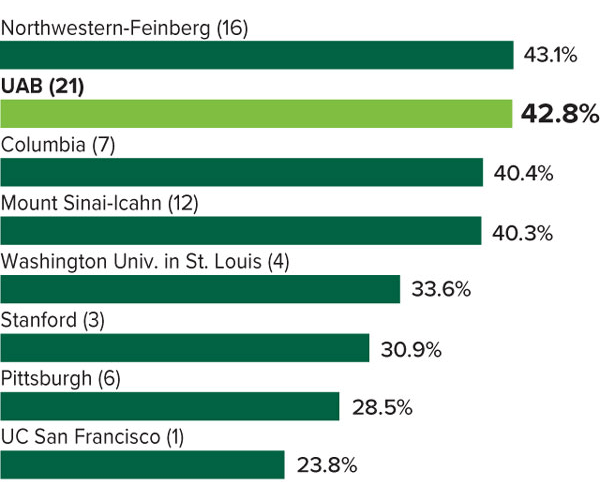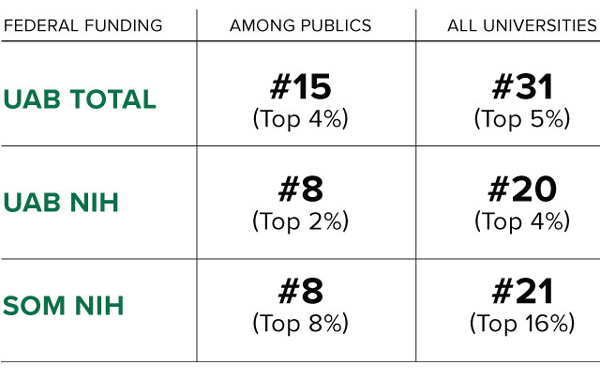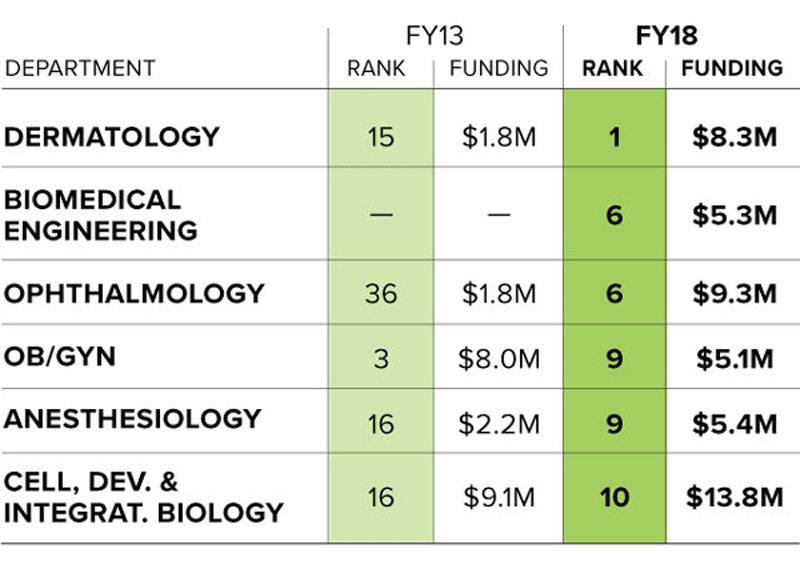I’m writing to share news of remarkable growth in NIH funding that has catapulted UAB’s School of Medicine into what can best be called the “Elite Eight” of academic medical centers in the United States that have grown by more than $100 million in National Institutes of Health funding over the past five years.
Colleagues and friends,
I’m writing to share news of remarkable growth in NIH funding that has catapulted UAB’s School of Medicine into what can best be called the “Elite Eight” of academic medical centers in the United States that have grown by more than $100 million in National Institutes of Health funding over the past five years. I share this story because as leaders in Birmingham, we are all partners in the success of our region.
Thank you.
Ray L. Watts, M.D.
President
Research growth boosts UAB School of Medicine
NIH Research Funding
The "Elite 8"
The School of Medicine is among eight academic medical centers to see an increase of more than $100 million in the past five years.

Northwestern-Feinberg (16)
43.1%
UAB (21)
42.8%
Columbia (7)
40.4%
Mount Sinai-Icahn (12)
40.3%
Washington Univ. in St. Louis (4)
33.6%
Stanford (3)
30.9%
Pittsburgh (6)
28.5%
UC San Fransisco (1)
23.8%
In the past five years, the University of Alabama at Birmingham School of Medicine has climbed 10 places on the National Institutes of Health research funding rankings, from 31st in the nation to 21st. Total NIH funding during that period rose from $133,264,288 in 2013 to $234,390,799 in 2018. The story of how Alabama’s preeminent medical school came to be standing on the doorstep of the 20 top-funded schools in the nation is one of focused commitment.
“This growth is remarkable by any measure, and it is due to the vision, brilliance, hard work and results of the school’s leadership, faculty, staff, students, alumni and many dedicated supporters in and outside of UAB,” said UAB President Ray L. Watts. “The short- and long-term positive effects of this growth for UAB, Birmingham, Alabama and beyond, as well as for the future of healthcare everywhere, are tremendous.”
UAB Senior Vice President and Dean of the School of Medicine Selwyn Vickers agrees with Watts, whom he succeeded as SVP and dean in 2013.
“Over the past five years, UAB has been part of an elite group of eight academic medical centers that have experienced more than $100 million in net NIH funding growth,” Vickers said. “We enjoyed the second-highest percentage of growth — 43 percent — only scant percentage points behind the leader, Northwestern University. This growth is attributable to an incredible collaborative effort from University and Health System leadership down to the work done every day at every level of our institution.”
Outpacing our Peers
UAB's NIH funding continues to grow among our peer institutions in the Southeast and beyond.

UAB Total
Among Publics: #15 (top 4%)
All Universities: #31 (top 5%)
UAB NIH
Among Publics: #8 (top 2%)
All Universities: #20 (top 4%)
SOM NIH
Among Publics: #8 (top 8%)
All Universities: #21 (top 16%)
Leaders in the School of Medicine point to a systematic plan to boost NIH funding by concentrating on several key components.
One way to quickly move up in funding rankings is to secure large, collaborative grants, and UAB has seen success in that arena. The NIH provided $45 million to UAB to lead the Southern Network of the "All of Us" Research Program, a national effort to encourage and promote genomic medicine. Other large grants were awarded to the Center for Clinical and Translational Science, the Center for AIDS Research, the Antiviral Drug Discovery and Development Center, and the O’Neal Comprehensive Cancer Center.
An additional target firmly in leadership’s crosshairs is NIH funding via the “R01” grant, the primary funding source to establish and equip a laboratory. A strategic growth decision was made to help investigators get a second R01 grant. In 2016, the school launched a mechanism to achieve this goal, with internal funding available to allow investigators to do the necessary preliminary studies and acquire the data needed to apply for a second R01. Eleven investigators were funded in 2016, with grants of $50,000 per year for two years. Five more received funding in 2017 and six in 2018.
Recognizing the importance of seed funding, the school created the Academic Enrichment Fund to provide resources in 2014.
The fund provides resources contributed by the UAB Health System that the dean can tap for pilot studies, seed funding or recruitment efforts. These funds are central to UAB’s ability to compete on a national stage for the NIH grants that can be transformative, not just for UAB, but for the people of Alabama’s communities.
Six in the Top 10
In six years, UAB has seen an increase from one School of Medicine department to six ranked in the Top 10 nationally in NIH funding.

Dermatology Department
FY13
Rank: 15Funding: $1.8M
FY18
Rank: 1Funding: $8.3M
Biomedical Engineering Department
FY13
Rank: -Funding: -
FY18
Rank: 6Funding: $5.3M
Ophthalmology Department
FY13
Rank: 36Funding: $1.8M
FY18
Rank: 6Funding: $9.3M
OB/GYN Department
FY13
Rank: 3Funding: $8.0M
FY18
Rank: 9Funding: $5.1M
Anesthesiology Department
FY13
Rank: 16Funding: $2.2M
FY18
Rank: 9Funding: $5.4M
Cell, Dev. & Integrat. Biology Department
FY13
Rank: 16Funding: $9.1M
FY18
Rank: 10Funding: $13.8M
“That, of course, is the ultimate goal,” said Anupam Agarwal, M.D., executive vice dean of the School of Medicine. “Can we, through science, make a meaningful difference in the lives of the people of Alabama and our region? Many of these NIH grants target key diseases in our state — diabetes, cancer, kidney disease, obesity. These diseases are a huge burden in Alabama, and we need to target our research to find the needed treatments, not to see our rank increase, but to provide answers to the most problematic diseases affecting our population.”
Another strategy to boost the number of research dollars coming in is to boost the number of researchers at the university. That can mean attracting new faculty and retaining those already here. UAB’s investment in new burgeoning fields in medicine is also paying dividends. The Hugh Kaul Precision Medicine Institute, the Informatics Institute, Proton Therapy Center and the UAB-HudsonAlpha Center for Genomic Medicine are cutting-edge programs in cutting-edge fields. All present opportunities for researchers to expand their horizons and make exciting new discoveries.
Of course, the School of Medicine does not operate in a vacuum. UAB has enjoyed a heady stream of accomplishments that have touched every facet of the university. Overall research funding to UAB topped $500 million in 2018, and the university just completed its largest fundraising campaign ever — a $30 million naming gift for the O’Neal Comprehensive Cancer Center put the Campaign for UAB over $1 billion. Total NIH funding to all schools within UAB reached nearly $300 million.